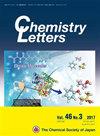通过碳-杂原子键形成电化学合成杂环化合物:直接和间接电解
IF 1.1
4区 化学
Q3 CHEMISTRY, MULTIDISCIPLINARY
引用次数: 0
摘要
电化学有机合成是一种通过碳-杂原子键形成来构建杂环化合物的环保方法,因此备受关注。在此,我们将介绍产生杂环的电化学反应的代表性实例,并根据它们是直接电解还是间接电解进行讨论。本文章由计算机程序翻译,如有差异,请以英文原文为准。
Electrochemical Synthesis of Heterocyclic Compounds via Carbon–Heteroatom Bond Formation: Direct and Indirect Electrolysis
Electrochemical organic synthesis has attracted attention as an environmentally friendly method for constructing heterocyclic compounds via carbon–heteroatom bond formation. Herein, we describe the representative examples of electrochemical reactions to produce heterocycles, and discuss them according to whether they involve direct or indirect electrolysis.
求助全文
通过发布文献求助,成功后即可免费获取论文全文。
去求助
来源期刊

Chemistry Letters
化学-化学综合
CiteScore
3.00
自引率
6.20%
发文量
260
审稿时长
1.2 months
期刊介绍:
Chemistry Letters covers the following topics:
-Organic Chemistry-
Physical Chemistry-
Inorganic Chemistry-
Analytical Chemistry-
Materials Chemistry-
Polymer Chemistry-
Supramolecular Chemistry-
Organometallic Chemistry-
Coordination Chemistry-
Biomolecular Chemistry-
Natural Products and Medicinal Chemistry-
Electrochemistry
 求助内容:
求助内容: 应助结果提醒方式:
应助结果提醒方式:


